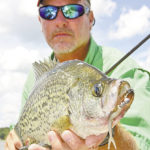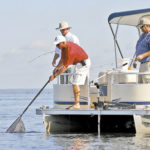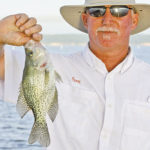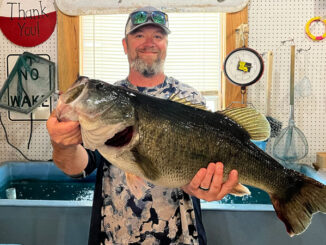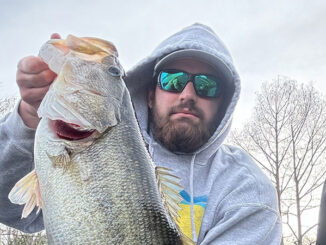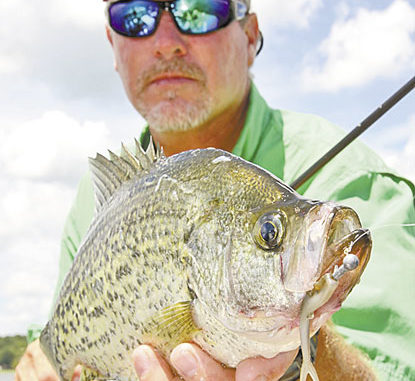
If you think winter and spring are the only times to catch these tasty fish, you’ve never visited Toledo Bend in the summer.
J.T. Thompson forgot his small minnow buckets. He winced with every sunscreen-lathered hand that grabbed fresh bait from his big bucket jammed-packed with over a pound of minnows.If he didn’t figure something out soon, he would wind up on the wrong end of a mutiny on the high seas of Toledo Bend.
Like crappie fishing at Toledo Bend during August, it looked like our trip might come to an inevitable end way too soon. If Thompson could only figure out a way to keep the minnows swimming and the crappie biting.
Noe Garcia pulled up next to Thompson’s party barge in the nick of time. If anybody would have a spare minnow bucket on board, it was this venerable Toledo Bend crappie guide.
Already positioned and with corks in the water, Garcia’s words hovered over the water.
“I’ll just throw it in the water, and it will float to you.”
And float it did. Only thing was that Thompson’s borrowed minnow bucket floated away from him rather than to him. Seeing no choice but to pull all lines in and go get it, Thompson laughed when he finally idled up next to the rogue runaway.
“This is kind of like crappie fishing Toledo Bend during August,” he chuckled. “You might think it’s all over, but no. You might not catch 100 fish a day like you did in late spring and early summer, but you can still catch sac-a-lait, crappie, white perch — whatever you want to call them.”
A 10-year crappie guide at Toledo Bend, Thompson admitted that, although anglers could still catch crappie during August, things are a little bit different now than they were just a few weeks ago. He has to work a little harder, and he has to move around a little bit more, but the Living The Dream Guide Service owner sizzles while others around him suffer.
According to Thompson, the first difference between early and late summer is that the water temperature is more stabilized from the surface down to the thermocline. It’s pretty much the same temperature in this zone. This means crappie don’t have to stay deep, and some of them will venture up into shallower brushpiles in the creeks.
“They may be in a pile suspended 20 feet down in 40 feet of water, or they may be in a pile that’s only 10 feet deep,” Thompson said. “It seems like it’s one extreme or the other during August. But you can bet they won’t be any deeper than the thermocline.”
The second difference is that piles that had been producing nothing but crappie now begin to provide a smorgasbord of fish ranging from crappie to catfish, barfish, white bass, spotted bass and bream. So from a purely fishing point of view, August may even be preferred by anglers who believe variety is the spice of life.
But it doesn’t matter how good an angler you are, if you don’t have your own brushpiles out, or you don’t know the location of already established piles, you’re at a severe disadvantage.
Thompson and his fellow guides have spent a lot of time constructing brushpiles that they hold close to their vests, but there are still ways to go about finding crappie this time of year even if you don’t want to go to the trouble to make your own piles.
“This lake is littered with brushpiles,” Thompson said. “So there’s a good chance you could find a couple good ones just by watching your electronics. But Toledo Bend is also full of natural structure. Think about it. Wherever you see a big stump, there is a big tree top down there somewhere.”
Thompson isn’t naïve enough to think that every stump in the lake has a big tree top somewhere around its base, but he says plenty of the larger stumps have tops that fell and got tangled up in lower limbs or surrounding timber. And those that did get hung up are still sitting right there.
“Also,” he continued, “many of these larger stumps have limbs sticking off of them under the water where you can’t see them. These trees shed as the lake was coming up, and the lower limbs are still there because they are protected in the water. If you’re coming to the lake without any knowledge of brushpiles, get around those bigger stumps.”
If you live close enough to Toledo Bend that you want to invest some time and effort putting out your own brushpiles, you would do well to build them just like Thompson builds them.
It’s not an exact science by any means, but there are some things you can do to increase your chances of building and sinking piles that will actually hold crappie rather than just take up space at the bottom of the lake.
“First off, we use sweet gums and willows to build our piles,” Thompson said. “And of those two, sweet gums are better because they hold their leaves longer. Even after sweet gum leaves turn brown, they hang on to the limbs and keep creating that dynamic habitat that attracts baitfish and sac-a-lait.”
Thompson uses a lot of willows that he helps keep cut down at his wife’s nursery, but he says they just don’t last very long, and their leaves fall off too soon. On the other hand, his sweet gum piles are still there and producing crappie two or three years later.
Regardless of whether he uses sweet gum or willows, Thompson says the best piles are those that “have the green.” Green leaves always make a brushpile more active. All kinds of algae and other stuff grows on the green leaves, and that is what attracts the minnows that in turn attract the crappie.
“You’ve always got to have a good base built up, but having the green is most important,” Thompson said. “When the green is gone off our piles, we refresh our most productive holes with new stuff early in the year to give them time to build up with algae, minnows and fish.”
Knowing where to sink a brushpile is just as important as keeping them green. And even with as much experience as Thompson has, he still gets it right only about one pile out of four. His best piles are located in areas that would attract fish even without a pile, places where the brush enhances rather than creates.
A good example would be a 4-foot drop on a long, extended point. This kind of spot will already attract crappie, but the addition of a brushpile will concentrate them in an easy-to-mark spot to which anglers can return again and again.
“It’s my belief that the best piles are the ones that are positioned on migration routes,” Thompson said. “Look for areas where fish will move in to spawn and back out again. As they follow these particular paths, they come across a brushpile, and I think it kind of imprints in the fish. A migration route will make the difference between a good pile and a bad one.”
When fishing brushpiles or the big stumps, Thompson keeps it as simple as he can. He proudly proclaims that he fishes one way and one way only — with a minnow rigged on a gold Aberdeen hook with a 1/0 or 2/0 split shot crimped on the line about 10 inches above the hook.
He holds his minnow just under the water, flips the bail of his spinning reel and raises his rod as high as he can reach before flipping the bail back and lowering his minnow down to the top of the brush.
“For a normal-sized person, this pull and drop will put his minnow about 12 to 15 feet down — exactly where we want it,” Thompson said. “Then we hold our rod tips about 4 to 6 inches above the surface. That gives us plenty of room to pull up on fish when they bite. The last thing you want is your rod up high when you get a bite. You’re going to look a little funny trying to set the hook.”
Thompson wrapped up by explaining why he believes it’s important to leave a pile while the fish are still biting. He’s learned that if he catches every crappie off a pile, there’s no reason for other fish to come in on it.
“If you catch them all, there’s no fish left for other fish to school to,” he said. “When crappie are biting, all that action kind of calls in surrounding fish. So if we leave them biting, that brushpile is calling in more fish as we’re idling away. As long as you leave them biting, you can fish a pile every single day of the summer and catch fish.”
Toledo Bend may not be as exciting now as it was a couple months ago, but as many anglers start thinking about things like hunting season and getting the kids back in school, Thompson is still catching crappie and living the dream.
Contact J.T. Thompson at 318-228-5870.
Shiner survival guide for more crappie
By fishing nothing but shiners all year long, J.T. Thompson with Living The Dream Guide Service at Toledo Bend has learned what to do and what not to do with them to keep them alive and make them more attractive to crappie.
First off, he likes little bitty shiners because he believes big shiners eliminate some bites from smaller fish.
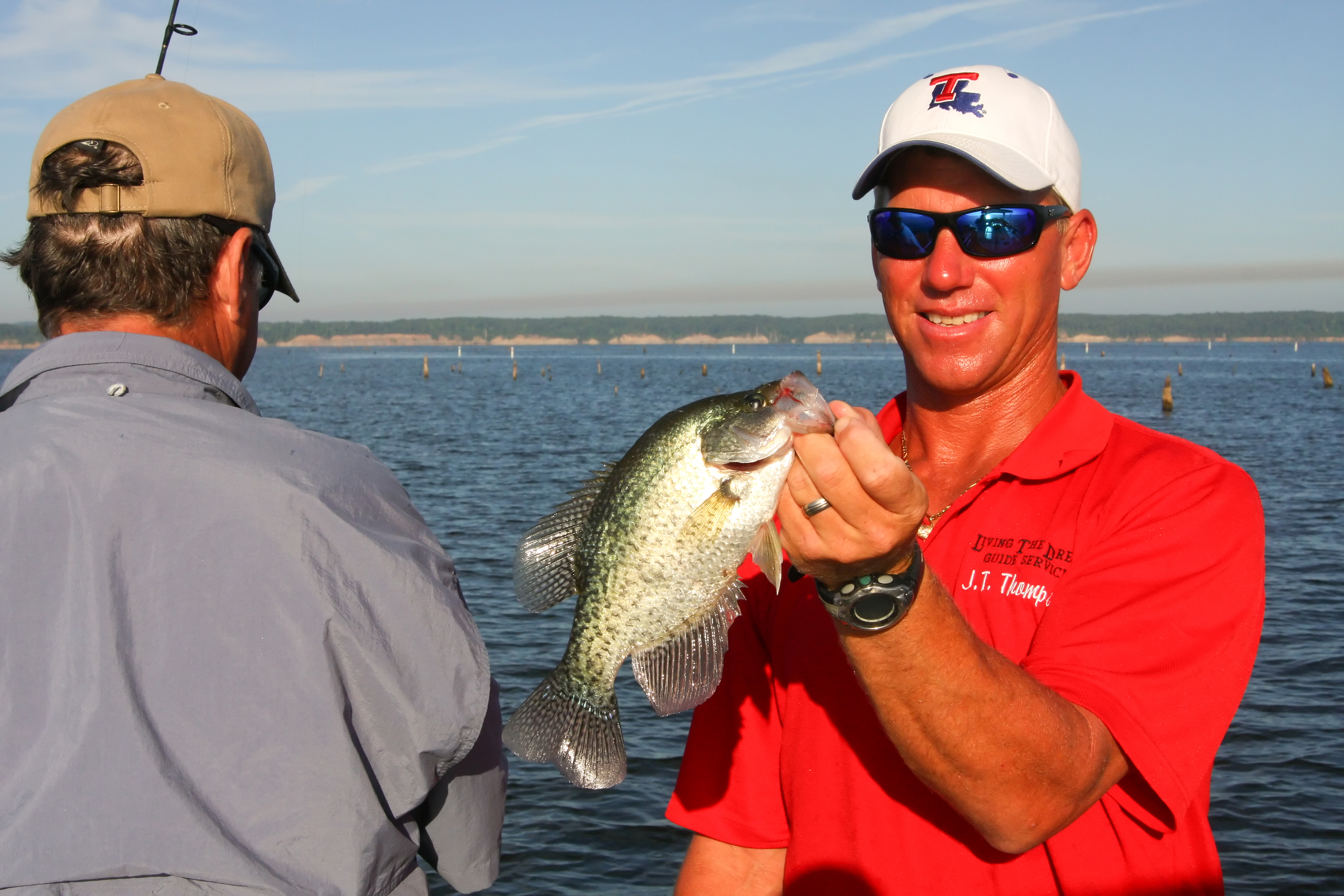 “Big fish will eat small shiners, but small fish don’t really eat big shiners that much,” he said. “So I’m not eliminating any bites that I might if I used nothing but big shiners.”
“Big fish will eat small shiners, but small fish don’t really eat big shiners that much,” he said. “So I’m not eliminating any bites that I might if I used nothing but big shiners.”
Thompson also likes to fish small shiners because they may attract some fish that might already be full from gorging on shad all morning long. His reasoning is that something small and bite-sized is a lot harder to pass up than a bigger meal when they are full.
“Say your wife comes in and tosses you some peanuts after you’ve already eaten supper,” he said. “You’re a lot more likely to grab a couple of them as opposed to if she had set another steak down in front of you.”
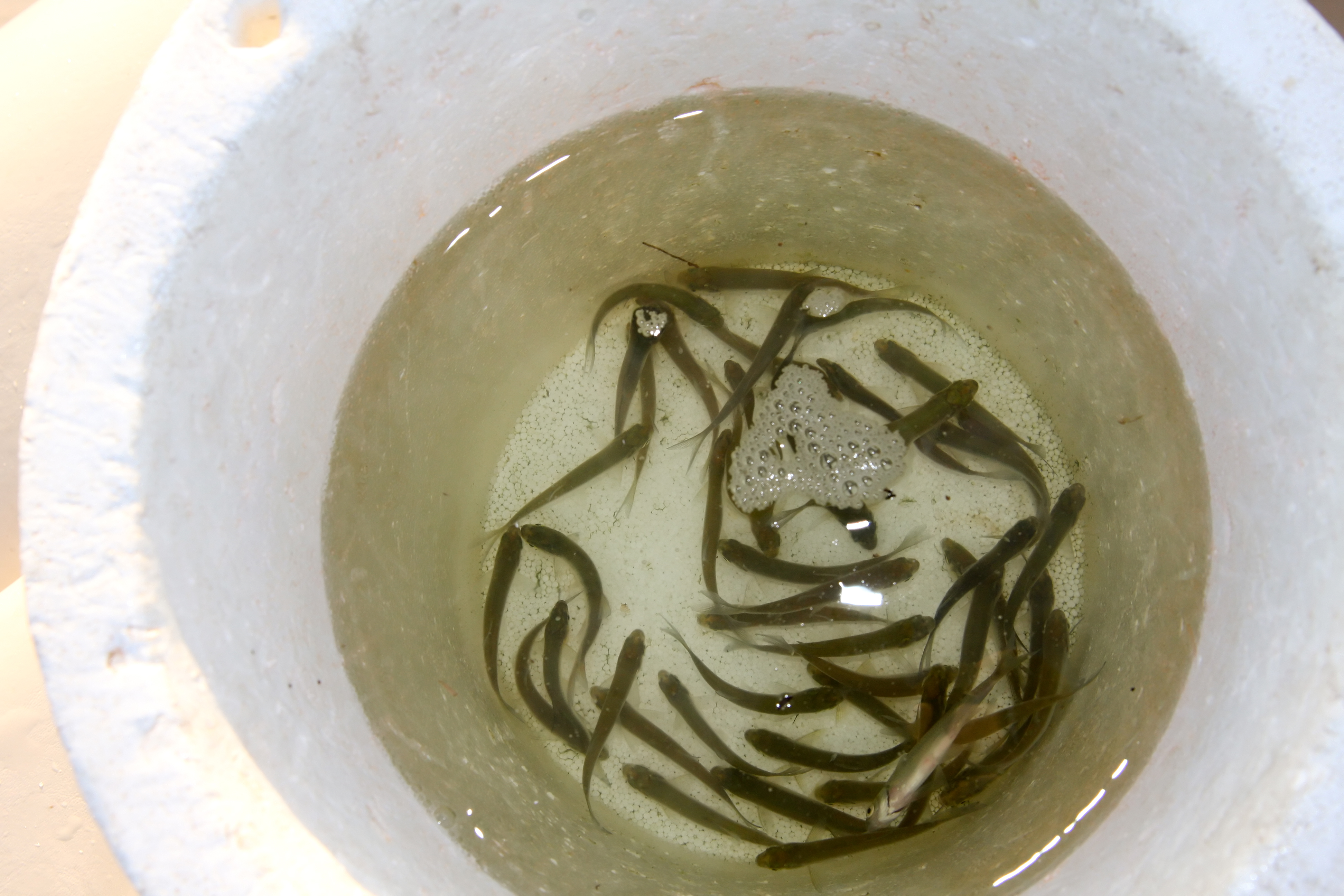
Keeping shiners alive during the summer is a challenge that Thompson meets by filling his bait bucket with the water that comes in his bags of shiners and adding some ice to the bucket to keep them cool.
“I just use the ice out of the machine down at Toledo Town,” he said. “There is a chemical in the water that comes with the shiners that breaks up the chlorine that might be in the ice. There’s really not enough chemical in that ice to really hurt them, anyway.”
A third precaution Thompson makes is keeping smaller Frabill minnow buckets on his boats so he can pull some shiners out of his main bucket and put them in easy reach all around his pontoon boat.
“That keeps everybody’s hands out of the main bucket, and that keeps them going a lot longer,” he said. “Those smaller buckets are more convenient because you don’t have to keep going back to the big bucket, but they also keep your big stash of minnows alive a lot longer.”
